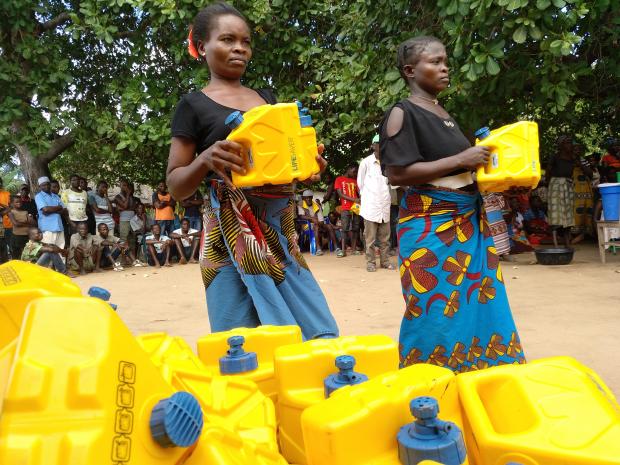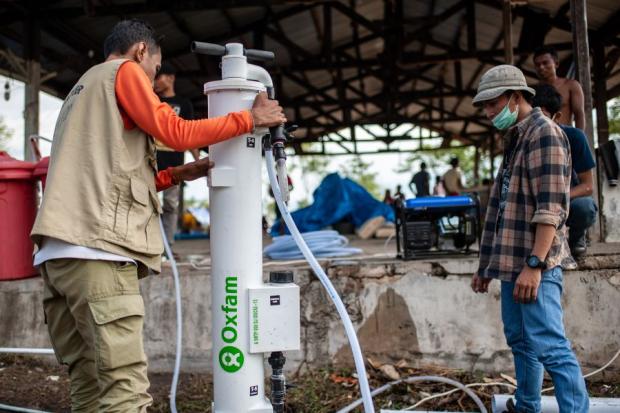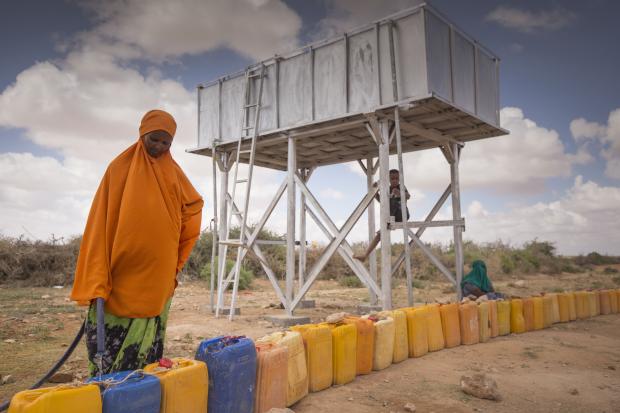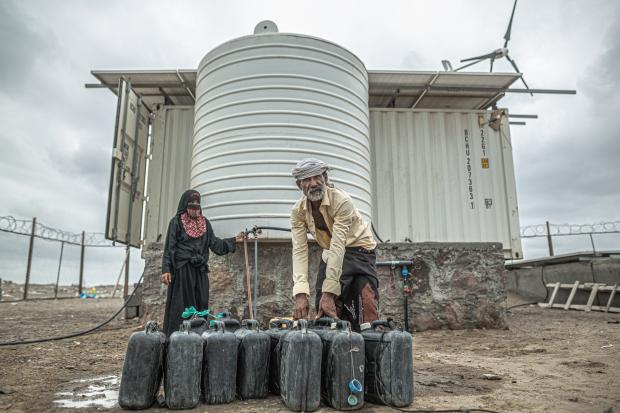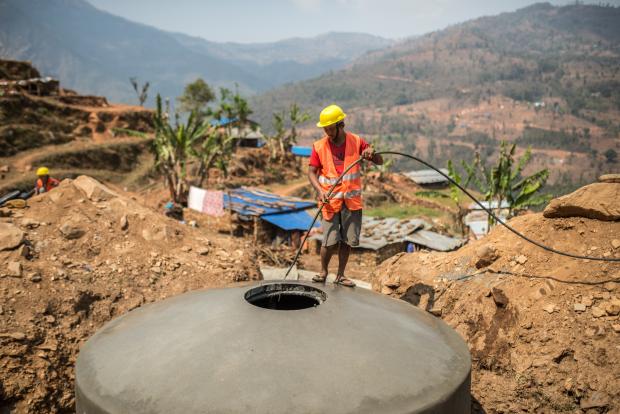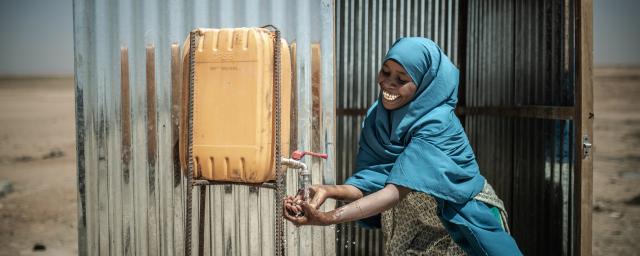
Somalia is suffering from a severe drought since 2016. Oxfam works to strengthen the communities’ recovery capacities against the impacts of drought, outbreaks of waterborne diseases and the risks of conflict due to limited access to safe water. Photo: Pablo Tosco/Oxfam
Over the past half century, Oxfam has forged the way in water and sanitation provision. Our water engineers are renowned for their speed and efficiency, providing large-scale water supplies and disease-preventing sanitation facilities to millions of vulnerable people in the world, even in the most challenging environments.
Working alongside partners on the ground, we are committed to developing innovative, long-term and cost-effective solutions that are tailored to each community’s unique needs and can reduce levels of poverty and disease.
Clean water is not just a luxury to some, it’s a seeming impossibility. Providing clean water and access to sanitation where they’re needed is an essential part of our humanitarian work. And it all starts with constantly searching for new, ground-breaking ideas that work well now and stand the test of time.
LifeSaver Cubes in Mozambique
Fast action can stop an emergency turning into a crisis. One month after Cyclone Idai devastated Southern Africa, Oxfam and its local partner organizations in Mozambique were still finding thousands of isolated people cut off from any aid or rescue. Almost all water sources were contaminated, and majority of latrines had been smashed.
In the face of cholera outbreaks in other parts of the country, we knew we had to act fast to get clean water to the community. Given the difficult terrain, it would be impossible to truck water straight to the community.
That’s where the life-saver cube comes in. This hand-held pump can turn the dirtiest of water into clean safe drinking water through an inbuilt hand pump. It is lightweight and perfect for transporting to areas that are hard to reach. The teams got the life-saver cubes to the community by car, canoe and on the back of motorbike. (Photo: Misozi Tembo/Oxfam)
Water filters in Indonesia
In every disaster, water and sanitation are the most urgent needs, as well as food. After a massive earthquake followed by a tsunami hit Central Sulawesi, Indonesia, in September 2018, the water supply infrastructure and pipes were critically damaged. The city of Palu became dependent on a fleet of water trucks that were under huge strain to meet demand.
The fastest and most efficient way to provide clean water is through water purification. Oxfam’s water, sanitation and hygiene (WASH) team brought in water treatment equipment called the SkyHydrant, that converts ground water into safe drinking water without the need for power or chemicals. It can produce 1,200 liters of clean water per hour from a bore hole – enough for around 500 people per day. (Photo: Hariandi Hafid/Oxfam)
Desalination units in Somalia and Yemen
As in the entire Horn of Africa area, due to climate change droughts are becoming more recurrent and more severe in Somalia. The population, mostly pastoralist and nomadic, has lost its livestock and with it, their livelihoods.
Oxfam aims to strengthen the communities' recovery capacities against the impacts of limited access to safe water. It includes providing innovative and sustainable solutions such as the installation of water desalination systems activated with solar energy.
Brackish (high saline) water is an increasingly common problem. In some communities underground sources contain salt and sandy water. The plant allows filtrating this contaminated water and converting it into fresh and drinking water for the local community as well as people fleeing the drought. (Photo: Petterik Wiggers/Oxfam)
Khor Omeira region, in Lahj Governorate, is an arid area about two hours from Aden, on the west coast of Yemen. Most of its inhabitants live from fishing. There are no basic services. People struggle to have enough water to cover their basic needs. They usually take it directly from the sea or from deep wells out of which the water comes salty. Most families can’t afford to buy water, of which the price has doubled because of the conflict.
In Ras Al Ara and Al Mudaraba settlements, Oxfam built a desalination unit that runs on solar panels and wind power. With this innovative project, families have clean water at a 50% lower price than what they paid the merchants, which they can use for drinking and cooking. (Photo: Pablo Tosco/Oxfam)
The longest ever water pipeline in Democratic Republic of Congo
The Fizi territory in the South Kivu region, DRC, is one of the most inaccessible places. As the population has grown, so has the demand for water, putting pressure on the few existing water infrastructures in the area. Most of the water sources and wells have been damaged during armed conflicts. Families are forced to consume unsafe water from stagnant sources, that puts them at the risk of contracting deadly water-borne diseases such as cholera.
Oxfam started the construction of a more than 100-kilometers-long gravity-fed water supply system, that taps into a river source in Mitumba mountain ranges. As far as we know this pipeline is one of the longest ever to be installed by an NGO. Once completed, this pipe will provide safe water to more than 80,000 people across the main surrounding towns. (Photo: Alexis Huguet/Oxfam)
Solar water treatment plants in South Sudan
In South Sudan, one in two people don’t have access to clean water. Many use river water for cooking and drinking, causing water-borne diseases like typhoid and cholera. Oxfam has built a new solar-powered water treatment plant in the Gumbo area of Juba.
The plant produces a minimum of 300 m3 per day and serves an estimated 15,000 people with drinking water. It was designed to be easy to operate and require minimal maintenance and spare parts. It doesn’t depend on fuel, which is expensive and in short supply in South Sudan. There is a complete distribution network, including three water kiosks and a water truck filling station. Oxfam is training community members to look after and maintain their own water supply. (Photo: David Lomuria/Oxfam)
Gravity water supply system in Nepal
In Nepal, the 2015 earthquake damaged many water sources in rural villages located in the mountains, like in Dhading district. The earthquake caused the underground water supply to move and communities’ existing water supplies to completely dry up. People were forced to leave their homes due to the lack of access to water.
To bring water back to the community in an even more accessible way, Oxfam built a gravity water supply system to support 266 households (1,500 people), as well as three schools. Taps are connected to their homes and women no longer have to go and collect water as they did before the earthquake. (Photo: Aurélie Marrier d'Unienville/Oxfam)
Beating poverty with water for all
We have a vision of a world where everyone has safe clean water to drink. A world where every single person has access to decent sanitation. A world where no one's life is threatened by deadly waterborne diseases.
Pioneering ideas have the power to change countless lives for the better. With your support, we’ll continue to innovate to achieve a just world without poverty.
